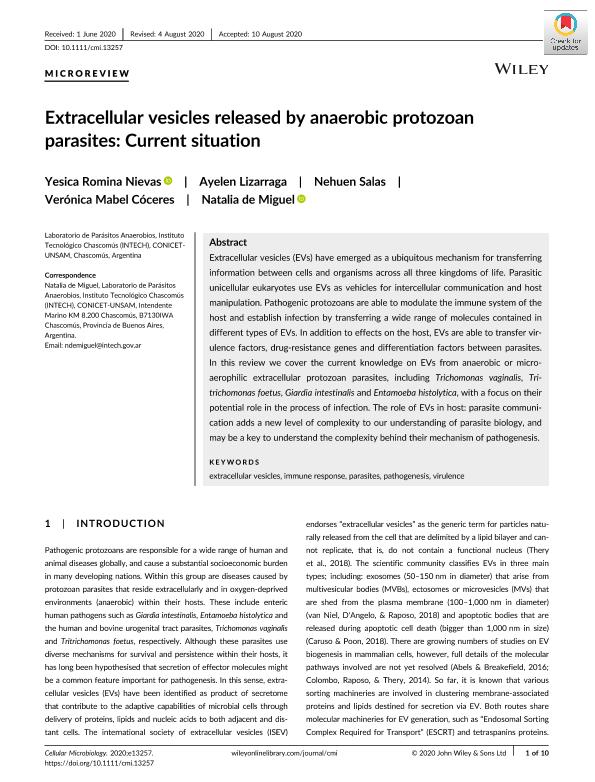Artículo
Extracellular vesicles released by anaerobic protozoan parasites: Current situation
Nievas, Yésica Romina ; Lizarraga, Ayelen
; Lizarraga, Ayelen ; Salas, Nehuen
; Salas, Nehuen ; Cóceres, Verónica Mabel
; Cóceres, Verónica Mabel ; de Miguel, Natalia
; de Miguel, Natalia
 ; Lizarraga, Ayelen
; Lizarraga, Ayelen ; Salas, Nehuen
; Salas, Nehuen ; Cóceres, Verónica Mabel
; Cóceres, Verónica Mabel ; de Miguel, Natalia
; de Miguel, Natalia
Fecha de publicación:
11/2020
Editorial:
Wiley Blackwell Publishing, Inc
Revista:
Cellular Microbiology (print)
ISSN:
1462-5814
e-ISSN:
1462-5822
Idioma:
Inglés
Tipo de recurso:
Artículo publicado
Clasificación temática:
Resumen
Extracellular vesicles (EVs) have emerged as a ubiquitous mechanism for transferring information between cells and organisms across all three kingdoms of life. Parasitic unicellular eukaryotes use EVs as vehicles for intercellular communication and host manipulation. Pathogenic protozoans are able to modulate the immune system of the host and establish infection by transferring a wide range of molecules contained in different types of EVs. In addition to effects on the host, EVs are able to transfer virulence factors, drug-resistance genes and differentiation factors between parasites. In this review we cover the current knowledge on EVs from anaerobic or microaerophilic extracellular protozoan parasites, including Trichomonas vaginalis, Tritrichomonas foetus, Giardia intestinalis and Entamoeba histolytica, with a focus on their potential role in the process of infection. The role of EVs in host: parasite communication adds a new level of complexity to our understanding of parasite biology, and may be a key to understand the complexity behind their mechanism of pathogenesis.
Palabras clave:
EXTRACELLULAR VESICLES
,
IMMUNE RESPONSE
,
PARASITES
,
PATHOGENESIS
,
VIRULENCE
Archivos asociados
Licencia
Identificadores
Colecciones
Articulos(CCT - LA PLATA)
Articulos de CTRO.CIENTIFICO TECNOL.CONICET - LA PLATA
Articulos de CTRO.CIENTIFICO TECNOL.CONICET - LA PLATA
Citación
Nievas, Yésica Romina; Lizarraga, Ayelen; Salas, Nehuen; Cóceres, Verónica Mabel; de Miguel, Natalia; Extracellular vesicles released by anaerobic protozoan parasites: Current situation; Wiley Blackwell Publishing, Inc; Cellular Microbiology (print); 22; 11; 11-2020; 1-10
Compartir
Altmétricas



